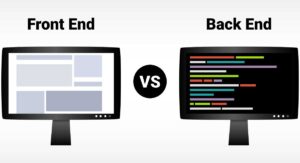React is a leading front-end library for building interactive user interfaces on websites and web applications. Introduced by Facebook in 2011 for its feed, React remains at the forefront of UI design, and with the right tools, developers can unlock its full potential.
With quality tools comes more productivity and efficiency. This article looks at some of the most used React Developer Tools. As a full-stack developer, you can begin working through these tools to gain expertise in this area. We will also introduce you to an opportunity to gain professional certification through our full stack web development program.
The History of React and Its Importance for Developers
Facebook initially introduced React, and Instagram soon adopted it in 2012. A year later, it was rolled out to the public.
Though it’s one of the top choices of developers around the world today, it was not without resistance from the developer community for its unconventional integration of Markup and JavaScript.
2014 witnessed the starting of #ReactjsWorldTour conferences, which played a big role in turning dismissers into advocates. The following years have seen widespread acceptance of React, with major enterprises adopting it. Amazon, Netflix, Airbnb, Twitter, Uber, and more are among them.
In 2015, Facebook expanded the React ecosystem by open-sourcing React Native, enabling native mobile app development for Android and iOS using React.js. Facebook maintains an active development team dedicated to its enhancements and community support.
According to a study, React devtools is utilized by 4.2 percent of websites for which there is a recognized JavaScript library. This makes up 3.4 percent of all websites worldwide.
Also Read: A Guide to Software Engineer Interview Questions
Why Is it Important for Developers?
As a developer, here are some reasons you should consider adding React to your skill set:
- React is flexible: React can be used to create various types of user interfaces for different platforms, such as web, mobile, desktop, and virtual reality.
- Developers will love React: React adopts a component-based method for code reusability and modularity, offers an explicit syntax for ease of coding, and is supported by numerous enhancing tools and libraries.
- React has Facebook’s resources: This is perhaps the biggest highlight. As Facebook created it, it is also maintained by them. A dedicated team is improving it, releasing new features and bug fixes. On top of that, it also provides resources for learning and using React, such as documentation, tutorials, blog posts, and videos.
- Large and active community: As one of the most popular libraries, it has a large and active community of developers contributing to its development. Developers can also find online platforms to ask questions, get answers, and learn from each other.
- DOM model: React uses a virtual DOM (Document Object Model) that updates only the parts of the UI that have changed instead of re-rendering the entire UI. This means reloading or updating the entire page or large portions, even for small changes, is optional.
- Easy to test: With React, developers can test individual components in isolation using tools like Jest and Enzyme. React also supports snapshot testing, which compares the rendered output of a component with a previous version and detects any changes.
What are React Developer Tools, and Why are they Needed?
As a React developer, you will have access to some of the best tools in the development industry. Let’s look at React tools and why you should use them.
React Developer Tools is a set of tools designed to help developers work with React. These developer tools may be extensions, frameworks, or libraries that make the development process more manageable. They are available in web browsers like Chrome and Firefox. These tools offer various functionalities that help debug and optimize React applications.
While React development is not impossible without these tools, what they do is they make the whole process efficient and faster. Here is how it is achieved.
- Enhanced Inspection and Debugging: These tools allow straightforward and efficient inspection and debugging of applications.
- Ease of Installation: It can be effortlessly integrated into browsers, making a robust development resource a click away.
- Component Inspection: With the “components” tab, developers can swiftly review and modify the root React components on a page without complications.
- Application Re-rendering Analysis: The tool has options to let you understand when and where changes were made. It has color-coded flame graphs to inform you.
In short, React Developer Tools are the cherry on top of the cake of React development. It enables a smooth development environment, making everything faster and more efficient.
Let’s look at some of the top development tools you should consider as a full-stack developer.
Also Read: Understanding Front-end vs. Back-end Development: Career Guide 2024
Which are the Top React Developer Tools?
In this section, we will familiarize you with some of the top development tools in the industry. If you are an aspiring React developer, you’ll want to add these to your repertoire.
Evergreen
What is It?
Evergreen, maintained by Segment, is an open-source JavaScript framework. It is designed to evolve with both present and future design needs.
It has out-of-the-box readiness with enhanced react components, providing developers agility while ensuring flexibility when more control is desired. It is built on top of a React UI Primitive for endless composability. Evergreen offers easy Server Side Rendering (SSR) and automatic hydration. It also bundles its own CSS-in-JS solution from ui-box.
Features:
- Immediate readiness post-installation.
- Built for enterprise demands.
- Intuitive implementation.
- Comprehensive documentation.
- Composability and adaptability.
Why Use It?
Evergreen stands as a dynamic solution that’s ready from the get-go. Its applications are not just functional but also design-forward. Evergreen is easy to use right away and makes apps look good while being flexible.
Bit
What Is It?
Bit is one of the top tools in the React ecosystem. It streamlines the creation, sharing, and management of React components.
Developers leverage Bit to construct and disseminate quickly and access React components. It brings together publishing, distributing, and even altering third-party components. Its functionalities are a blend of NPM and Git but optimized for React.
Features:
- Seamless component sharing.
- Organized component accessibility.
- Flexible tool selection.
- Holistic CI cycle.
- Encourages shared component workflow.
Why Use It?
Bit’s marketplace offers a buffet of components, allowing developers to use, modify, and preview components. It can be tailored to a perfect fit for projects.
Storybook
What Is It?
Storybook is a dynamic user interface design tool. It works well to enrich React’s component-driven architecture.
Developers use Storybook to create, develop, and test UI components. It doubles as a playground for UI components and a developmental habitat. With this tool, developers can craft and showcase interactive visual components easily.
Features:
- Swift UI development.
- Zero initial setup.
- Open-source nature.
- Preventative built-in filters.
Why Use It?
Storybook provides a platform to design UIs in isolation. It allows you to handle hard-to-reach states and edge cases without running the full app.
Redux
What Is It?
Redux Toolkit is the official toolset for efficient Redux development, offering an opinionated, all-inclusive approach to enhance the Redux experience.
The toolkit streamlines the process of setting up the store, creating reducers, and managing immutable update logic, simplifying the common challenges in Redux development.
Features:
- Offers utilities for everyday tasks like store setup and reducer creation.
- Integrates widely-used Redux addons.
- Draws inspiration from libraries like Immer and Auto Dux.
- Enables writing “mutative” immutable logic and auto-generating state “slices.”
Why Use It?
Redux Toolkit emphasizes efficient and less code development, allowing developers to concentrate on the core application logic.
Jest
What is It?
Jest is a JavaScript Testing Framework designed to ensure the correctness of JavaScript codebases.
It’s employed extensively for testing JavaScript projects, including those using Babel, TypeScript, Node, React, Angular, Vue, and more.
Features:
- Zero-config out-of-the-box setup
- snapshots for tracking large objects
- isolated tests that run in parallel
- comprehensive API
- features to ensure code coverage without additional setup
- easy mocking capabilities and detailed exception reports.
Why Use It?
What sets Jest apart is its focus on simplicity and delight in testing. With the philosophy of making testing delightful, well-documented, and extensible, it has become an essential tool for many developers.
Reactide
What Is It?
Reactide is one of the top integrated development environments (IDE) used extensively in web app creation.
The tool enables real-time project rendering. As developers engage with a React JSX file, the effects materialize instantly in a custom browser simulator. Its integrated Node Server eliminates external setup hassles. Moreover, it has state flow visualizations that grant on-the-fly insights, minimizing the coding-checking cycle.
Features:
- Unified development environment.
- User-friendly configurations.
- Advanced component visualization.
- Rapid hot module reloading.
Why use it?
Reactide offers speed in development, erasing the boundary between code and its visual output. It simplifies setup stages and empowers developers with state visualization.
Also Read: All About the Software Development Life Cycle
How to Install React Developer Tools and Use Them
React Developer Tools is a Chrome DevTools extension tailored for the React JavaScript library. It’s an indispensable tool for those diving deep into React.js applications. It offers a smoother debugging experience and a better look into React component structures. Here is how you can install the tool.
Installing the Tool:
- Navigate to the official Chrome Web Store link for React Developer Tools.
- Click on “Add to Chrome”.
- Once added, head to the Extensions Tab on the top right of your browser. You’ll notice the tool within the dropdown, confirming its addition.
Utilizing the Extension:
- Detecting React.js Presence: To determine if an application utilizes React.js, open the desired application and click on the extension tab, followed by React Developer Tools. A colorful extension icon denotes React.js usage, while a grayscale icon indicates its absence.
- Inspecting & Editing Components: Right-click within your application and choose “Inspect” or use the shortcut Ctrl+Shift+I. This brings up Chrome DevTools. From the top bar, select the two arrows to reveal a dropdown.
- Click on “Components” to unveil the React Component tree. This space is your playground to inspect, modify, and understand each component’s props, state, and structure.
- “Profiler” lets you monitor your app’s performance in-depth, ensuring smooth user experiences.
This tool is a small yet powerful addition to your React development arsenal. You will find excellent tools here that make React development a breeze.
Master React Development Today!
There are a lot of tools with large user bases that make development easy for React developers as well as front-end developers. However, it takes careful study and persistent effort to master them and build a career in React development. You can gain a steady footing in the industry by mastering some of the React Developer Tools mentioned in this article.
To start your journey, consider enrolling in our full stack web development program. Dive deep into the web development world with our 9-month program. Master both front-end and back-end development and benefit from hands-on labs and capstone projects spanning four diverse domains. Boost your professional stature with our post graduate certificate and enhance your career.
Ready to begin your learning journey with React devtools? Get started today!
You might also like to read:
What Do Coders Do and What Kind of Coder Salary Can You Expect?
React Developer Tools: A Comprehensive List
What Does a Coder Do? A Beginner’s Guide






